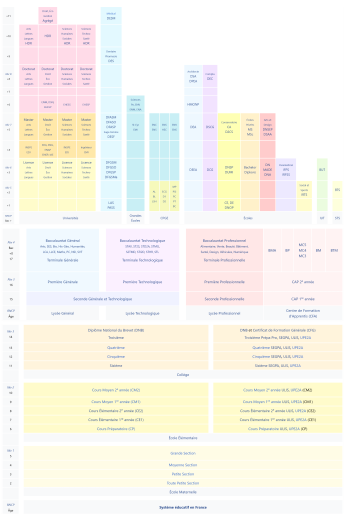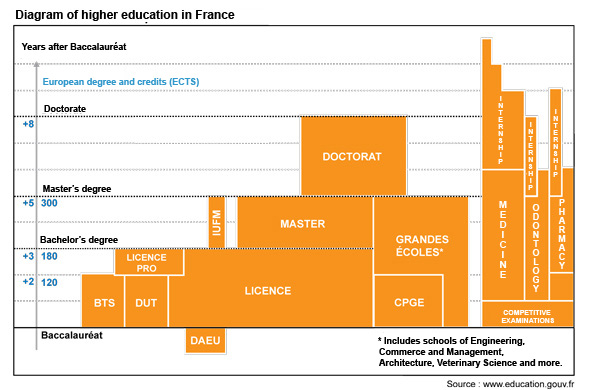Education in France
The education system in France includes the schools and colleges of the country.
The school system is operated at about 90 percent of the public sector. In higher education, non- governmental agencies are more strongly represented in the so-called Grandes écoles. The management of schools and colleges is essentially performed by the 30 " academies ". These can be viewed as a counterpart to the regions in education.
Compulsory education
Compulsory education was introduced in France on 28 March 1882. There are now also home schooling or unschooling possible (for example, non- scolarisation called ). Want a child in consultation with the parents or initially not go to school, parents report it to the city, checked in this case at regular intervals the family conditions, health and academic progress of the child. About 20,000 children attend school in France.
Day school
Schools in France are basically all-day schools. Classes begin at 8:00 clock and ends at 16 and 17 clock at the Collège, 18 clock at the Lycée. Preschools and primary schools still offer also subsequent care facilities when the size of the community allows it. Allen children a cafeteria food is offered, the cost of this will depend on the income of the parents. For children from large families it's free.
Nursery school
The École maternelle is visited by most of the children in France. It is a type of state preschool, but also has similarities with the German kindergarten. The école maternelle is not mandatory. Age: 2 ½ -6. The École maternelle is a facility with care, upbringing and education function. There exists a fixed according to national guidelines of the Ministry of Education curriculum, which is not binding though, but as a result the École maternelle as a preparatory institution for primary school ( école élémentaire ) holds.
Primary school ( l' école = primaire )
The primary school in France lasts five years; the school years are called CP ( cours préparatoire ), CE1 ( cours élémentaire 1), CE2, CM1 ( cours moyen 1) and CM2. Age: 6-11. In Class 1 and 2, the education, in class 3-5, a practice phase takes place. Starting at the first class a foreign language is taught within the meaning of Europeanization.
Secondary education
Following the elementary school, all students are four years the College, a secondary school. They receive instruction in French, mathematics, two modern foreign languages, history, geography, civics, SVT (Sciences de la vie et de la terre, a mixture of biology and earth science ), physics, chemistry, technology, visual arts, music, education and sports. There is also the opportunity to learn a regional language, Latin or Greek. At the end of the Collège undergo the students a test, through which they receive a certificate of completion, the diplôme national du brevet.
Secondary education
In the field of secondary education, it is possible for three years to attend a lycée; distinction is made between lycées d' enseignement général et technologiques (general and technical) and lycées d' enseignement professionnel ( vocational), which nowadays both courses are multi-skilled, often offered in the same school, the Lycée.
Lycée d' enseignement général
Teaching at the Lycée
After a joint instruction for all students in this type of school in the first year, the Seconde ( 10th year ), the students opt for the Première ( 11th grade ) and the terminals ( Year 12 ), the last two years before graduation ( baccalauréat ), for one of three profiles ( série ): L ( littéraire, literary), ES ( économique et sociale, economic and social sciences ) or S ( scientifique, scientific). Within these profiles, many other choices are given. Required for all students, the following subjects:
- French and literature ( Seconde and Première )
- Philosophy ( terminals )
- History, geography and civics
- First modern foreign language
- Second modern foreign language (or regional language or Latin for L)
- Mathematics ( for L: mathematics and computer science )
- Sports
- Enseignement Scientifique (biology and physics / chemistry)
- TPE ( Travaux personnels encadrés ) term paper on a topic more or less freely chosen
The individual profiles are characterized by their own compulsory subjects, different curricula and different numbers of hours. The respective profile-specific compulsory subjects are:
- Profile S: Mathematics, Physics - Chemistry, SVT (Sciences de la vie et de la terre, a mixture of biology and earth science ) or SI (Engineering Science )
- Profile ES: Economic and social science, natural science
- Profile L: literature ( in the Terminal ), Natural Science
In addition to these required courses, all schools have to choose another subject within their profile in the Offer; up to two additional courses can be, if desired.
Baccalaureate ( Baccalauréat )
The Baccalauréat is stored in twelve subjects; a reform that would reduce this number to six subjects, was initially postponed. The tasks for all subjects will be provided nationally by the same date centrally. In one to three subjects, the Abitur examination takes place at the end of the premiere (in all profiles: French, L and ES: natural science in L: math computer science ). The other subjects are tested at the end of the terminals. Depending on the profile, the individual subjects are weighted differently by giving them different coefficients. When calculating the overall final grade only the performance in these tests are used, the performance of previous years, however, play no role.
The High School in France takes 12 years in Germany - depending on the province - 12 or 13 years.
Reform of secondary schools
After Darcos, the then Minister of Education in France, had in 2008 announced a reform of the secondary schools, but this was met with resistance, this reform was put on hold. First, Richard Descoings, director of the University of Sciences Po, tasked to interview students, teachers and parents in France. Part of the results was noted on his blog ( Lycée pour tous ). Then, after it had come in summer 2009 in a reshuffle, was presented at the beginning of the school year by the new Education Minister Luc Chatel, the reform of secondary schools. The new version of the secondary schools is very much kept conservative than the reform proposed by Darcos and follows broadly the early 2009 report presented Apparu in which the deputy Benoist Apparu (UMP ) presents his proposal for reform.
Universities
The academic education is characterized by the coexistence of the grandes écoles and universities. The Grandes écoles can usually be visited after visiting the classe préparatoire that is usually offered by secondary schools. The Grandes écoles have against the French universities a higher reputation, lower student enrollment and higher personal care. Among the more important of the Grandes écoles include the École Polytechnique, the Ecole Normale Supérieure, the École nationale d'administration (ENA ), the École nationale supérieure d'arts et métiers ( Ensam ) and the École Centrale Paris. As part of the Europe-wide harmonization of degree structures in the context of the Bologna process, the LMD system is also introduced to French universities. LMD means that one after the Licence (equivalent to Bachelor, after 3 years), Master ( after 5 years) and doctorate ( after 8 years ) can be purchased. The traditional national accounts ( DEUG, Licence, Maîtrise, DEA and DESS) will be allocated in this process. End of 2009, approximately 2.25 million students were studying at French universities.










